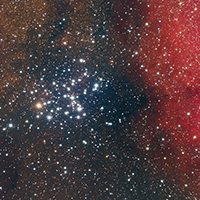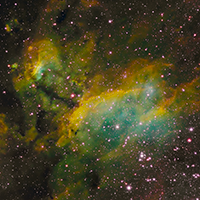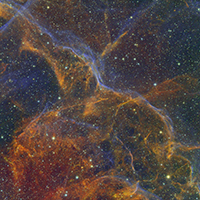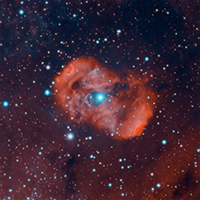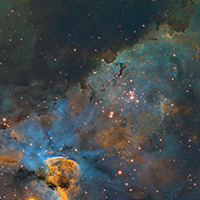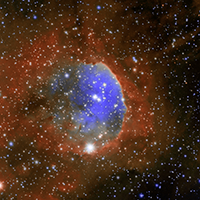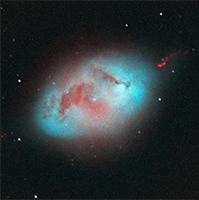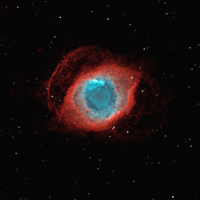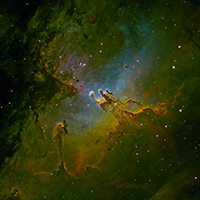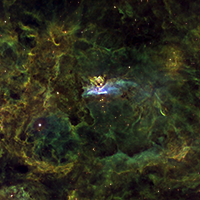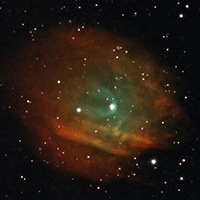Tagged: Narrowband
07-Jul-2019
The Butterfly Cluster, Messier 6, is an open cluster of hot blue stars with the brightest member being an orange giant star. Behind the cluster is the orange light of the Milky Way, and a beautiful cloud of excited Hydrogen alpha gas.
12-Feb-2019
The Skull & Crossbones Nebula is an active star-forming region approximately 20,000 light years away.
10-Aug-2018
IC 4628, sometimes known as The Prawn Nebula, is an emission nebula located around 6000 light-years away in the constellation Scorpius
28-Jan-2018
The Vela Supernova Remnant is an expanding bubble of ionized gas 800 light years away, caused by a supernova explosion 12000 years ago. This image is a small section of the bubble, presented as a narrowband combination of light emitted by Hydrogen alpha, Sulfur II and Oxygen III.
02-Jul-2019
4200 light years distant, NGC 6164 is a bipolar emission nebula was created by a massive O-type star, 40 times as larger than the Sun.
19-Apr-2019
One of the largest nebulae in the sky, the Carina Nebula is visible to the naked eye in the southern sky.
19-Jul-2018
Shaped like a cats paw, NGC 6334 is a stellar nursery and emission nebula 5,500 light years away in the constellation Scorpius. This image comprises of emission line data for Sulfur-II, Hydrogen-alpha and Oxygen-III, mapped to red, green, and blue respectively.
13-Mar-2018
The Gabriela Mistral Nebula lies close to the Carina Nebula ~7500 light years distant in the far-southern sky. This image is a narrowband representation showing glowing ionised gasses, Hydrogen-alpha (orange), Sulfur-II (red), and Oxygen-III (blue).
28-Nov-2017
NGC 1360 is known as the Robin's Egg Nebula, primarily due to its blue hue from strong oxygen-III emissions. It is a diffuse planetary nebula 1794 light years away. Presented is a narrowband image with H-alpha emissions mapped to red, and OIII emissions mapped to both green and blue (HOO palette).
02-Feb-2017
NGC 2736, known as the Pencil Nebula is a part of the supernova remnants from the Vela pulsar, 815 light years away.
16-Aug-2016
I've already done the Helix Nebula in natural colour, so I've imaged it again in narrowband. Lots of H-alpha and Oxygen-III, but barely any Sulfur-II.
05-Jul-2016
The Eagle Nebula is located 7000 light years away and is home to the famous "Pillars of Creation", shown in the centre of this image. This photograph is presented in the Hubble narrowband palette, which shows the distrubution of Hydrogen (green), Oxygen (blue), and Sulfur (red) gasses.
16-Jun-2016
Narrowband images are rarely presented as true color light. When imaging in narrowband, colors are assigned to each channel based on the specific emission lines captured. One of the most common choices is the SHO Hubble Pallet, but the choices for mixing colors are endless. Here are 9 examples of how an image of a planetary nebula may be colored.
07-Jun-2016
NGC 6357 is a diffuse nebula in the constellation Scorpius. The nebula contains many proto-stars shielded by dark disks of gas, and young stars wrapped in expanding gases. It is also known as the Lobster Nebula. Presented is a narrowband SHO photograph in the Hubble Space Telescope palette.
10-May-2016
For my first foray into narrowband imaging, I have chosen a very dim & difficult target: planetary nebula Sh2-313, also known as Abell 35 and PK 303+40.1
Page: 1, 2
